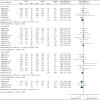Comparison of Standard and Transepithelial Corneal Cross-Linking for the Treatment of Keratoconus: A Meta-analysis
- PMID: 33575037
- PMCID: PMC7864754
- DOI: 10.1155/2021/6679770
Comparison of Standard and Transepithelial Corneal Cross-Linking for the Treatment of Keratoconus: A Meta-analysis
Abstract
Purpose: To compare the clinical results of standard corneal cross-linking (SCXL) with transepithelial corneal cross-linking (TECXL) in progressive keratoconus using a meta-analysis.
Methods: PubMed, EMBASE, and Cochrane Central Register of Controlled Trials were searched up to June 2020 to identify relevant studies. The PRISMA guidelines were followed. Primary outcomes were change in uncorrected distance visual acuity and maximum keratometry (K max) after CXL. Secondary outcomes were change in corrected distance visual acuity, mean refractive spherical equivalent (MRSE), spherical and cylindrical error, endothelial cells density (ECD), and central corneal thickness (CCT).
Results: Sixteen studies with a total of 690 eyes (SCXL: 332 eyes; TECXL: 358 eyes) were included. At the last follow-up, SCXL provided a greater decrease in maximum keratometry (K max) than TECXL (weighted mean difference (WMD) -1.12; 95% confidence interval (CI) -1.96, -0.29). For the other outcomes, there were no statistically significant differences.
Conclusions: Except for a greater decrease in Kmax with SCXL group, both groups have a comparable effect on visual, pachymetric, and endothelial parameters at 24 months after surgery. Larger studies with a longer follow-up time are necessary to determine whether these techniques are comparable in the long term.
Copyright © 2021 Yu Di et al.
Conflict of interest statement
The authors declare that they have no conflicts of interest.
Figures




Similar articles
-
Comparison of Efficacy and Safety Between Standard, Accelerated Epithelium-Off and Transepithelial Corneal Collagen Crosslinking in Pediatric Keratoconus: A Meta-Analysis.Front Med (Lausanne). 2022 Mar 17;9:787167. doi: 10.3389/fmed.2022.787167. eCollection 2022. Front Med (Lausanne). 2022. PMID: 35372437 Free PMC article.
-
Comparison of Epithelium-Off Versus Transepithelial Corneal Collagen Cross-Linking for Keratoconus: A Systematic Review and Meta-Analysis.Cornea. 2018 Aug;37(8):1018-1024. doi: 10.1097/ICO.0000000000001632. Cornea. 2018. PMID: 29847492
-
Comparison of Standard Versus Accelerated Corneal Collagen Cross-Linking for Keratoconus: A Meta-Analysis.Invest Ophthalmol Vis Sci. 2018 Aug 1;59(10):3920-3931. doi: 10.1167/iovs.18-24656. Invest Ophthalmol Vis Sci. 2018. PMID: 30073363
-
Conventional and transepithelial corneal cross-linking for patients with keratoconus.PLoS One. 2018 Apr 5;13(4):e0195105. doi: 10.1371/journal.pone.0195105. eCollection 2018. PLoS One. 2018. PMID: 29621306 Free PMC article.
-
Accelerated Versus Standard Corneal Cross-Linking for Progressive Keratoconus: A Meta-Analysis of Randomized Controlled Trials.Cornea. 2020 Feb;39(2):172-180. doi: 10.1097/ICO.0000000000002092. Cornea. 2020. PMID: 31369463
Cited by
-
The Impact of Standard Cross-Linking on the Corneal Optical Density-Age Relationship in Keratoconus After Mechanical Stripping of the Epithelium.J Ophthalmol. 2024 Oct 15;2024:8827837. doi: 10.1155/2024/8827837. eCollection 2024. J Ophthalmol. 2024. PMID: 39444422 Free PMC article.
-
Enhanced Riboflavin Stromal Delivery Using Microchannel-Assisted Iontophoresis for Corneal Crosslinking.Transl Vis Sci Technol. 2025 Mar 3;14(3):18. doi: 10.1167/tvst.14.3.18. Transl Vis Sci Technol. 2025. PMID: 40100211 Free PMC article.
-
Could Automated Objective Measurements Acquired at the Preoperative Stage Estimate the Corrected Distance Visual Acuity after Corneal Cross-Linking in Keratoconus?Ophthalmol Ther. 2024 Oct;13(10):2599-2614. doi: 10.1007/s40123-024-00993-0. Epub 2024 Aug 7. Ophthalmol Ther. 2024. PMID: 39110318 Free PMC article.
References
LinkOut - more resources
Full Text Sources
Other Literature Sources

